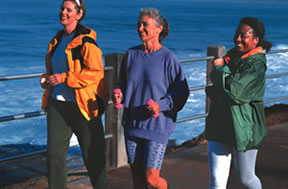|
Fitness Blog Covering Topics Of Interest Wednesday, October 28 2015
Your bone strength and size peaks by age 30. After that, bones tend to become less dense, making them more fragile and subject to Even if you’re older, exercise is still a great way to protect your bones. The physical stress placed on bones during exercise stimulates the growth of new bone tissue. The type of exercise you do matters. To bolster your bones, you need to get regular weight-bearing exercise. This includes weight lifting and resistance training, as well as any type of activity that forces you to work against gravity by standing or carrying your body’s weight, including running, walking, dancing, and stair climbing. Activities such as swimming or biking aren’t weight-bearing and thus don’t build bone. Generally, higher-impact activities (such as running) or resistance exercises (such as strength training) have a more pronounced effect on bone than lower-impact exercises, such as walking. Only the bones that bear the load of the exercise will benefit. For example, running protects bones in the hips and legs, but not the arms. A well-rounded strength training plan can benefit practically all of your bones. Because exercise improves your overall strength, coordination, and balance, it also makes you less likely to fall, which means less opportunity to break a bone. To read more about the many benefits of exercise and learn how to start an exercise program that works for you, contact Ronald on 07929 256856. Monday, October 05 2015
The next time you have a check-up, don’t be surprised if your doctor hands you a prescription to walk. Yes, this simple activity that you’ve been doing since you were about a year old is now being touted as “the closest thing we have to a wonder drug,” in the words of Dr. Thomas Frieden, director of the Centers for Disease Control and Prevention. Of course, you probably know that any physical activity, including walking, is a boon to your overall health. But walking in particular comes with a host of benefits. Here’s a list of five that may surprise you. 1. It counteracts the effects of weight-promoting genes. Harvard researchers looked at 32 obesity-promoting genes in over 12,000 people to determine how much these genes actually contribute to body weight. They then discovered that, among the study participants who walked briskly for about an hour a day, the effects of those genes were cut in half. 2. It helps tame a sweet tooth. A pair of studies from the University of Exeter found that a 15-minute walk can curb cravings for chocolate and even reduce the amount of chocolate you eat in stressful situations. And the latest research confirms that walking can reduce cravings and intake of a variety of sugary snacks. 3. It reduces the risk of developing breast cancer. Researchers already know that any kind of physical activity blunts the risk of breast cancer. But an American Cancer Society study that zeroed in on walking found that women who walked seven or more hours a week had a 14% lower risk of breast cancer than those who walked three hours or fewer per week. And walking provided this protection even for the women with breast cancer risk factors, such as being overweight or using supplemental hormones. 4. It eases joint pain. Several studies have found that walking reduces arthritis-related pain, and that walking five to six miles a week can even prevent arthritis from forming in the first place. Walking protects the joints — especially the knees and hips, which are most susceptible to osteoarthritis — by lubricating them and strengthening the muscles that support them. 5. It boosts immune function. Walking can help protect you during cold and flu season. A study of over 1,000 men and women found that those who walked at least 20 minutes a day, at least 5 days a week, had 43% fewer sick days than those who exercised once a week or less. And if they did get sick, it was for a shorter duration, and their symptoms were milder. |
 |



 breaks. Bone strength in later life depends upon your peak bone mass in youth. An active lifestyle in youth can increase maximum bone density.
breaks. Bone strength in later life depends upon your peak bone mass in youth. An active lifestyle in youth can increase maximum bone density.